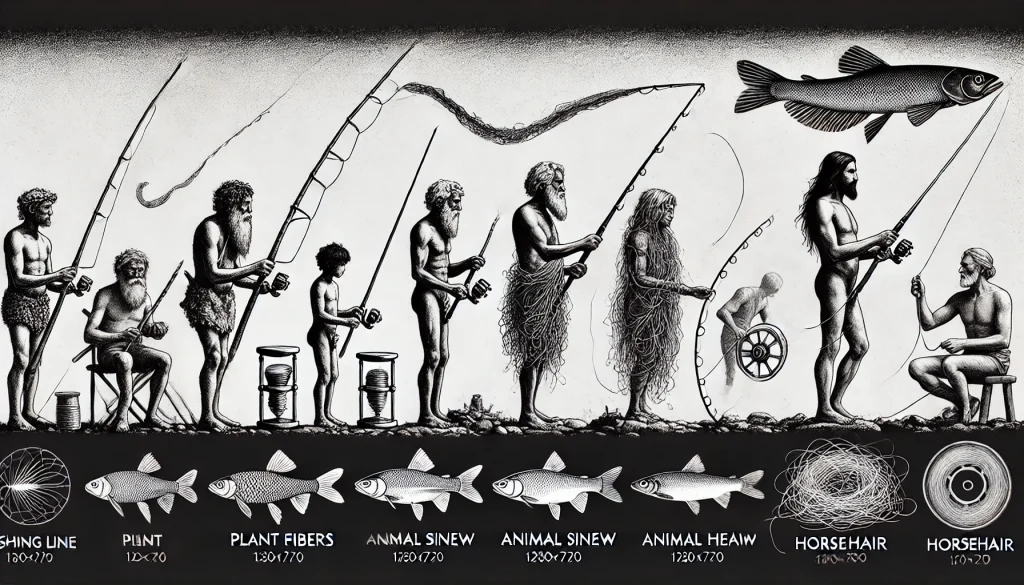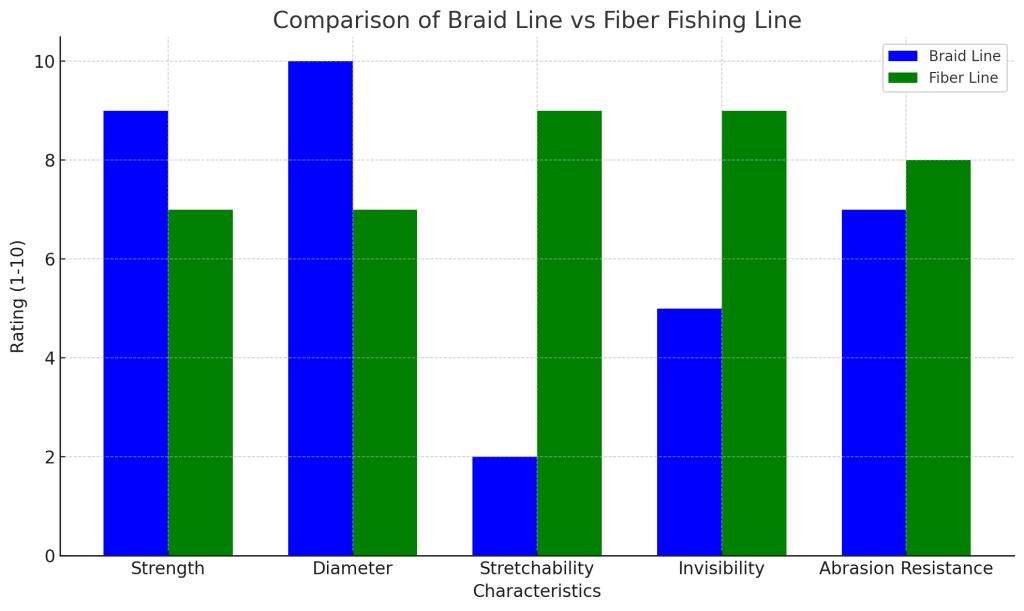Currently Empty: $0.00

Fishing enthusiasts have long debated the merits of braid line versus fiber fishing line. Both types of lines offer distinct advantages and drawbacks, depending on the angler’s needs and the type of fishing being pursued. Understanding the differences between these lines, particularly in terms of their pound-test (lbs) strength, can help you make an informed decision that enhances your fishing experience.
A Brief History of Fishing Lines

The history of fishing lines dates back thousands of years, with early anglers using materials like plant fibers, animal sinew, and even horsehair to catch fish. As time progressed, advancements in materials and technology led to the development of stronger and more durable fishing lines. The introduction of synthetic materials in the 20th century revolutionized the fishing industry, providing anglers with a wide range of line options, including braid and fiber lines.
Braid fishing line, made from woven fibers, became popular in the 1990s due to its incredible strength and durability. This type of line quickly gained a reputation for being tough and reliable, particularly for heavy-duty fishing. Fiber fishing line, on the other hand, encompasses a variety of synthetic materials, including nylon and fluorocarbon. These lines offer different characteristics, such as stretchability and invisibility underwater, catering to various fishing techniques.
What is Braid Fishing Line?
Braid fishing line is constructed by weaving together multiple strands of synthetic fibers, usually Dyneema or Spectra, to create a single, highly durable line. The weaving process gives braid line its distinct characteristics: thin diameter, high tensile strength, and minimal stretch. These attributes make braid line a popular choice for anglers targeting large, powerful fish, as it provides the strength needed to reel in heavy catches.
One of the most significant advantages of braid line is its low visibility in the water, particularly when fishing in clear or saltwater environments. The thin diameter also allows anglers to spool more line onto their reels, giving them greater control and distance when casting. However, braid line’s minimal stretch can be a double-edged sword; while it enhances sensitivity, it also increases the risk of line breakage under sudden, sharp tension.
What is Fiber Fishing Line?
Fiber fishing line is a broad category that includes several types of synthetic fishing lines, such as monofilament, fluorocarbon, and copolymer. These lines are typically made from nylon or other synthetic materials, offering a range of characteristics that can suit different fishing scenarios. Monofilament line, for example, is known for its flexibility and stretch, making it ideal for absorbing the shock of a fish strike.
Fluorocarbon line, another type of fiber fishing line, is prized for its invisibility underwater. This line refracts light similarly to water, making it nearly invisible to fish. Additionally, fluorocarbon is more resistant to abrasion than monofilament, making it a good choice for fishing in rocky or debris-filled waters. Despite these advantages, fiber fishing lines generally have a larger diameter than braid lines, which can affect casting distance and line capacity.
Pound-Test (Lbs) Rating: What It Means
The pound-test rating of a fishing line refers to the maximum amount of weight that the line can support before breaking. For example, a fishing line with a 10 lbs rating can withstand up to 10 pounds of force. This rating is crucial for anglers to consider when selecting a line, as it needs to match the size and strength of the fish they are targeting.
Braid fishing lines typically have a higher pound-test rating relative to their diameter compared to fiber lines. This means that a braid line with a thinner diameter can still have a high lbs rating, allowing anglers to use a stronger line without sacrificing casting distance or line capacity. On the other hand, fiber lines, particularly monofilament, tend to have a larger diameter for the same lbs rating, which can limit their use in certain fishing scenarios.
Comparing Braid and Fiber Fishing Line Lbs

When comparing the lbs rating of braid line versus fiber fishing line, it’s essential to consider the specific fishing conditions and the type of fish being targeted. Braid lines, with their higher tensile strength and lower diameter, are ideal for situations where anglers need maximum strength without compromising on line capacity. This makes braid lines particularly well-suited for deep-sea fishing, where large, powerful fish require robust gear.
Fiber fishing lines, while not as strong as braid lines at the same diameter, offer other advantages that can be crucial in different fishing environments. For instance, monofilament’s stretchability can absorb the shock of sudden fish strikes, reducing the risk of line breakage. Fluorocarbon’s invisibility underwater can be a game-changer when fishing in clear water, where fish are more likely to be spooked by visible lines.
Practical Considerations
Choosing between braid and fiber fishing lines often comes down to the specific requirements of the fishing trip. Anglers targeting large, aggressive fish in deep or saltwater environments may prefer braid lines for their strength and thin diameter. The high lbs rating of braid lines allows for greater control and the ability to handle heavy catches without breaking.
In contrast, fiber fishing lines may be more suitable for freshwater fishing or situations where stealth is paramount. The stretch and flexibility of monofilament can be beneficial in environments where fish are more likely to make sudden, unpredictable movements. Similarly, the low visibility of fluorocarbon can help increase catch rates in clear water conditions.
Final Thoughts
The decision between braid line and fiber fishing line ultimately depends on your fishing style, the environment, and the type of fish you’re targeting. Both types of lines have their unique strengths and limitations, and understanding these can help you make the best choice for your fishing needs.
Braid lines offer unmatched strength and durability, making them the go-to choice for heavy-duty fishing. Their higher lbs rating relative to diameter provides anglers with the power needed to handle big catches. On the other hand, fiber lines, particularly monofilament and fluorocarbon, offer flexibility and invisibility, making them ideal for more stealth-oriented fishing.
In conclusion, while both braid and fiber fishing lines have their place in an angler’s arsenal, the right choice depends on the specific demands of your fishing adventure. By considering the lbs rating, environment, and target species, you can select the line that will help you achieve success on the water.


